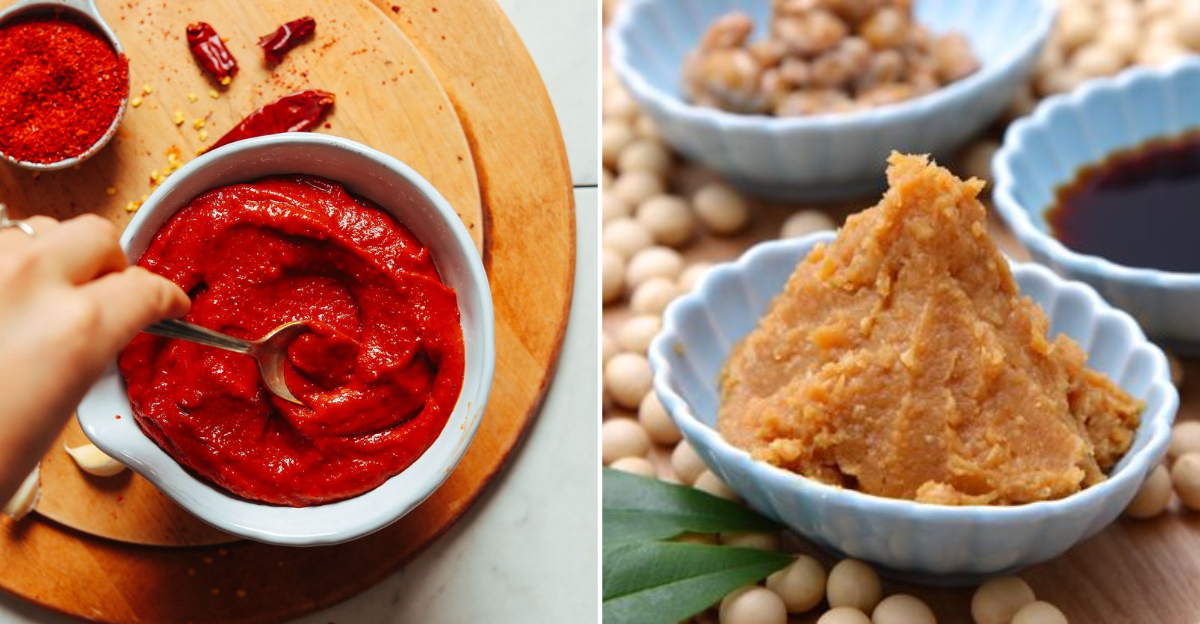20 Underrated Ingredients That Instantly Upgrade Any Dish

Ever stared at a dish that’s just missing something? We’ve all been there – cooking something that’s good but not great. The secret to creating extraordinary culinary experiences often lies in unexpected ingredients.
I’ve discovered 20 underrated kitchen heroes that can instantly elevate your cooking from bland to brilliant without fancy techniques or equipment.
1. Nutritional Yeast
These golden flakes pack a cheesy, nutty punch without any dairy. Vegans treasure it, but everyone should keep a jar in their pantry. Sprinkle it on popcorn, roasted vegetables, or pasta for instant flavor elevation.
Beyond the taste, it’s loaded with B vitamins and protein. The texture adds a satisfying dimension to dishes that might otherwise fall flat.
Just don’t confuse it with active yeast – they’re completely different beasts!
2. Pomegranate Molasses
Sweet, tangy, and impossibly complex, this Middle Eastern ingredient transforms ordinary dishes into extraordinary ones. The syrupy reduction of pomegranate juice adds fruity depth to dressings, marinades, and glazes.
My obsession began when a Lebanese friend drizzled it over roasted eggplant at dinner. I practically licked the plate! It balances fatty meats beautifully and makes an incredible addition to cocktails.
Just a teaspoon can revolutionize your vinaigrette game forever.
3. Smoked Paprika
Regular paprika pales in comparison to its smoked cousin. This Spanish spice brings campfire essence to everything it touches without requiring actual smoking equipment. The brick-red powder transforms humble eggs, potatoes, and chicken dishes.
Choose between sweet (dulce) and hot (picante) varieties depending on your spice tolerance. I sprinkle it on hummus, mix it into mayo, and add it to practically any dish needing depth.
The smoky complexity fools everyone into thinking you worked much harder on dinner.
4. Preserved Lemons
Salt-cured lemons develop an intense flavor that’s simultaneously bright, salty, and complex. North African cuisines have treasured them for centuries, but they deserve space in every modern kitchen.
I discovered them while attempting to recreate a Moroccan tagine and now add the chopped rinds to everything from grain bowls to roast chicken. The transformation is remarkable!
Make them yourself with just lemons, salt, and patience, or find them at specialty stores.
5. Gochujang
Korea’s famous fermented chili paste delivers heat with surprising depth. Unlike one-dimensional hot sauces, gochujang brings sweetness, umami, and complexity alongside its spice. The brick-red paste transforms marinades, stews, and dressings.
Start with a small amount – its potency can surprise you! I accidentally overwhelmed a batch of fried rice with a heaping tablespoon when a teaspoon would have sufficed.
The fermentation process creates layers of flavor that develop as you cook with it.
6. Sumac
Bright crimson sumac delivers lemony tang without any liquid. This Middle Eastern spice brings citrusy brightness to dishes when actual lemon juice would make things too wet. The dried, ground berries have a beautiful burgundy color and mouth-watering sour punch.
I first encountered it at a Lebanese restaurant sprinkled over hummus. Now I add it to salad dressings, yogurt dips, and roasted vegetables. It’s particularly magical on avocado toast or sprinkled over grilled meats just before serving.
7. Miso Paste
Far beyond soup, this fermented soybean paste works magic in countless dishes. The savory depth it provides is unmatched – try mixing a spoonful into butter for the world’s most umami-rich toast topping.
Choose white miso for milder applications and darker varieties for more robust dishes. Last winter, I stirred some into caramel for ice cream topping and nearly fainted from pleasure!
It enhances everything from salad dressings to marinades, cookies to glazes.
8. Black Garlic
Regular garlic transformed through time and heat into something extraordinary. The black cloves are sweet, tangy, and reminiscent of balsamic vinegar and molasses without garlic’s sharpness. They’re completely spreadable and packed with complex flavor.
I stumbled upon black garlic at a farmers market and became instantly obsessed. Try mashing it into butter, adding to vinaigrettes, or incorporating into pasta dishes.
The umami boost is remarkable, and the subtle sweetness works in both savory applications and desserts.
9. Za’atar
This Middle Eastern spice blend combines wild thyme, sumac, sesame seeds, and salt into a versatile flavor powerhouse. The herbaceous, tangy profile instantly transports ordinary dishes to extraordinary heights.
Sprinkle it over flatbreads, yogurt, eggs, or roasted vegetables. My morning avocado toast completely transformed when I added a generous pinch!
Regional variations exist throughout the Levant, with some families guarding their specific blend ratios like precious heirlooms.
10. Sherry Vinegar
Spanish kitchens have long treasured this aged vinegar for its remarkable depth. Unlike harsh white vinegar, sherry vinegar brings complexity, subtle sweetness, and nutty notes that transform ordinary vinaigrettes into something special.
I discovered it while attempting to recreate a restaurant salad and never looked back. A splash brightens soups, stews, and sauces at the last minute.
The oak-aged varieties develop incredible flavor complexity that puts basic vinegars to shame.
11. Dried Mushrooms
These wrinkly powerhouses pack more flavor than their fresh counterparts. Rehydrate them in hot water, and you’ll get intensely flavorful mushrooms PLUS an incredible umami-rich broth as a bonus. I always keep porcini, shiitake, and black trumpet varieties in my pantry.
The soaking liquid makes incredible risotto, and the chopped rehydrated mushrooms add meaty texture to vegetarian dishes. Once, during a snowstorm with bare cupboards, these pantry heroes transformed plain pasta into restaurant-worthy dinner.
12. Sorghum Syrup
Move over maple syrup – sorghum brings earthy, complex sweetness that’s uniquely compelling. This Southern staple has a mineral-rich depth that works beautifully in both sweet and savory applications.
I discovered it during a road trip through Kentucky and now use it in barbecue sauces, glazes for roasted vegetables, and baked goods.
The complexity reminds me of molasses but with brighter notes. Pour it over cornbread or biscuits for a truly transcendent experience!
13. Yuzu Kosho
This Japanese condiment combines yuzu citrus, chili peppers, and salt into an electrifying paste. The bright citrus notes dance with heat and salt to create something truly unique that wakes up any dish it touches.
A tiny dab transforms soups, grilled meats, and seafood. I first encountered it at a ramen shop and immediately ordered some online.
The green or red paste (depending on the chili used) keeps forever in the fridge, ready to rescue bland dishes with its vibrant personality.
14. Urfa Biber
These Turkish chili flakes deliver smoky, raisin-like sweetness alongside gentle heat. The purple-black flakes have a remarkable complexity that outshines regular red pepper flakes in every way.
I became obsessed after a chef friend sprinkled some over chocolate ice cream – an unlikely but mind-blowing combination! Try it on eggs, roasted vegetables, or grilled meats.
The subtle heat builds gradually rather than overwhelming the palate, while the fruity undertones keep you coming back for more.
15. Sichuan Peppercorns
These aren’t true peppercorns but berries that create a unique tingling, numbing sensation alongside citrusy flavor. The distinctive “ma la” effect transforms dishes from merely spicy to memorably complex.
Toast them lightly before grinding for maximum impact. I’ll never forget my first experience with proper Sichuan cuisine – the buzzing sensation was alarming until it became utterly addictive!
Try them in stir-fries, with roasted meats, or infused into oils.
16. Barberries
These tiny dried berries pack serious pucker power. Popular in Persian cooking, barberries (zereshk) bring vibrant ruby color and intense tartness that brightens rich dishes instantly. I discovered them while attempting to recreate a jeweled rice dish.
Their cranberry-like flavor provides perfect counterpoint to sweet or fatty foods. Soak them briefly before using, and consider tempering their sourness with a touch of sugar if needed.
17. Fenugreek Leaves
Dried fenugreek leaves (kasuri methi) deliver an intriguing maple-like aroma that’s essential in many Indian dishes. Just a pinch transforms ordinary curries into restaurant-quality experiences.
I spent years wondering why my homemade butter chicken lacked that certain something until discovering this magical ingredient. Crush the dried leaves between your fingers before adding to release their full aroma.
The unique flavor profile is impossible to substitute and works beautifully in creamy sauces and lentil dishes.
18. Aleppo Pepper
Named for the Syrian city, these burgundy flakes offer moderate heat with fruity, almost raisin-like undertones. Unlike harsh cayenne, Aleppo pepper brings complexity alongside its gentle burn. I sprinkle it on everything from eggs to pizza.
The slightly oily texture helps it cling to foods beautifully. During a dinner party last year, my simple roasted potatoes with olive oil and Aleppo pepper disappeared faster than any other dish – sometimes the simplest applications showcase special ingredients best.
19. Lao Gan Ma Chili Crisp
This Chinese condiment featuring crispy chili flakes, onions, and mysterious spices in oil has developed cult status for good reason. The complex flavor bomb makes literally anything taste better. I’ve caught myself eating it straight from the jar with a spoon!
Try it on eggs, noodles, rice, or even vanilla ice cream for a sweet-savory revelation. The iconic label featuring a stern-faced woman (the founder) is instantly recognizable to devotees who understand this isn’t just another hot sauce – it’s a lifestyle.
20. Asafoetida
This powdered resin might smell terrible raw, but transforms magically when cooked. Used widely in Indian cuisine, a pinch adds garlicky, oniony depth to dishes without actual alliums.
I discovered it while exploring vegetarian cooking from regions where onions and garlic are sometimes avoided. The initial sulfurous aroma completely disappears during cooking.
For those with allium allergies or digestive issues with onions and garlic, it’s absolutely revolutionary!
